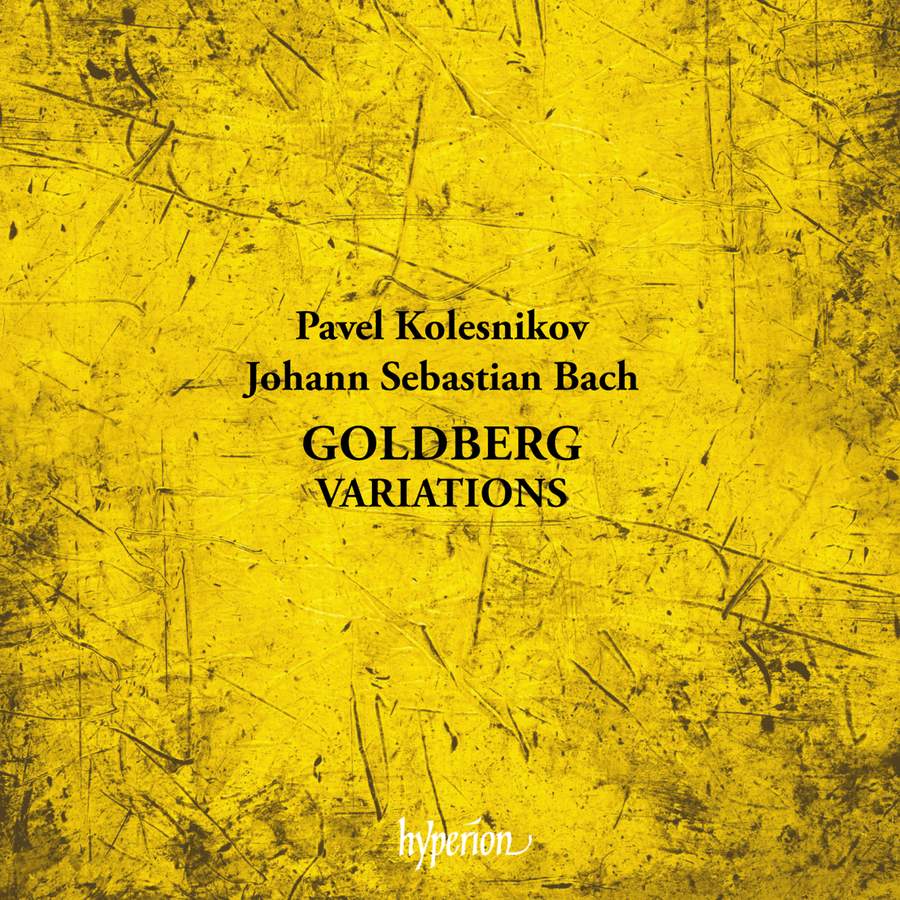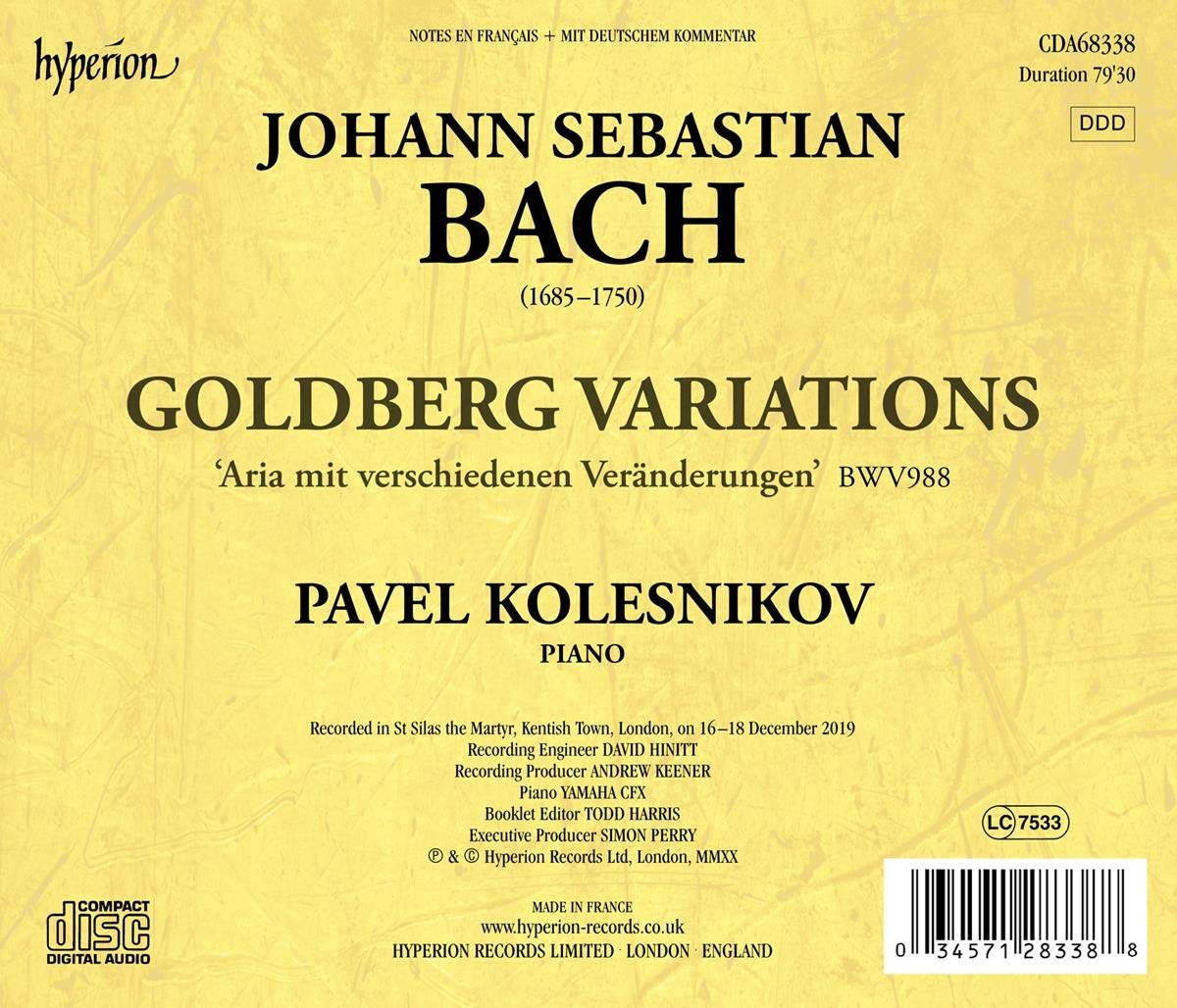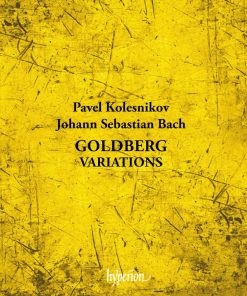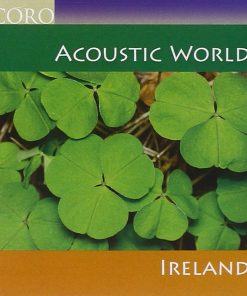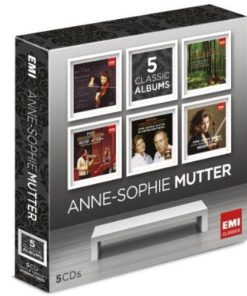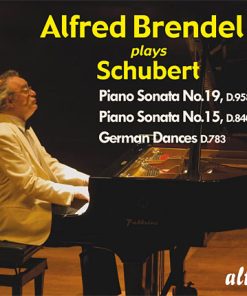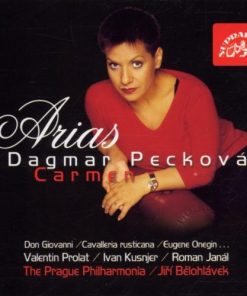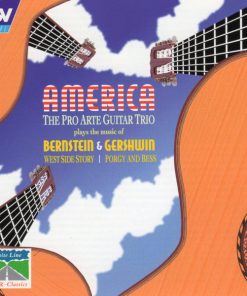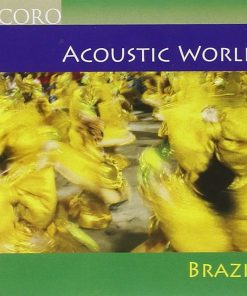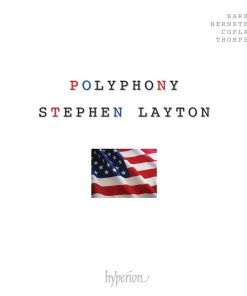BACH: GOLDBERG VARIATIONS – PAVEL KOLESNIKOV Hyperion
$ 20,99 $ 12,59

‘Intense, emotional and pure’ is how Pavel Kolesnikov describes the experience of making this recording, the fruits of a collaboration between the pianist and choreographer Anne Teresa De Keersmaeker. The spirit of the dance, so fundamental to Bach, is never far away in this compelling new account.
He needed only to have heard any theme to be aware—it seemed in the same instant—of almost every intricacy that artistry could produce in the treatment of it.
When Bach’s second son, Carl Philipp Emanuel, penned these words in his obituary of ‘the world-famous organist Mr Johann Sebastian Bach’, he may have been thinking above all of The Art of Fugue, and of the Musical Offering, Bach’s stupendous response to a challenge thrown at him by Frederick the Great. Yet for ‘every intricacy that artistry could produce’ in the exploration of a single theme, no composition by Bach—or, for that matter, by anyone else—surpasses the so-called Goldberg Variations, published in the autumn of 1741 as the fourth and final part of his Clavierübung cycle.
Together with Beethoven’s Diabelli Variations—a work distantly inspired by the ‘Goldbergs’—this ‘Aria mit verschiedenen Veränderungen vors Clavicimbal mit 2 Manualen. Denen Liebhabern zur Gemüths-Ergetzung verfertiget von Johann Sebastian Bach’ (‘Aria with divers variations for the harpsichord with two manuals, composed by Johann Sebastian Bach to refresh the spirits of music-lovers’) forms one of the twin peaks in the history of keyboard variations. The nickname comes from a story in Johann Nikolaus Forkel’s 1802 biography of Bach. As Forkel tells it, the variations were commissioned by the insomniac Baron (later Count) Hermann Carl von Keyserlingk, Russian ambassador at the Dresden electoral court, for his young resident harpsichordist Johann Gottlieb Goldberg (1727–1756), who may have been a pupil of Bach’s:
On one occasion the Count gave to understand that he would like to have some Clavier pieces for his [harpsichordist] Goldberg, which would be soothing and rather cheerful in character, and which might raise his spirits somewhat during his sleepless nights. Bach thought that he would best be able to fulfil this wish by composing variations, a task which he had hitherto regarded as thankless in view of the unchanging nature of the underlying harmonies.
Forkel also informs us that for his pains Bach received ‘a golden goblet with 100 Louis d’or’: worth some £2,000 today.
We should take this story with at least half a pinch of salt. Bach did not dedicate the variations to Keyserlingk, as etiquette—or anyone else—would have demanded; and it is hard to believe that he would have composed his most technically demanding keyboard work specifically for a thirteen- or fourteen-year-old, however talented. In any case, one could scarcely imagine a less likely non-chemical cure for insomnia than this work of dazzling, encyclopaedic scope: a whole musical universe evoked within the confines imposed by a single theme and its bass line. We do know, though, that Bach stayed with Keyserlingk in Dresden in the autumn of 1741. He may well have presented his host with a special copy of his newly published work, which Goldberg could then have studied and played to Keyserlingk, probably a few variations at a time. Did any of the original purchasers play all thirty variations right through?
The ‘Goldbergs’ are at once a contrapuntal tour de force, a celebration of keyboard virtuosity (several variations—especially those with hand-crossings—suggest that Bach knew Domenico Scarlatti’s recent Essercizi), and an exploration of every conceivable Baroque affect, from devil-may-care brilliance to profound reflective inwardness. Bach builds his mighty structure on a floridly galant ‘aria’ which appears in Anna Magdalena Bach’s notebook as ‘sarabande’, and may date from several years earlier. Some scholars have questioned the theme’s origins, though no one has made a convincing case that it is not Bach’s own. While several of the variations hint at the aria’s melodic outline, the chief binding elements are the strong, simple bass line (beginning with a descending scale—a traditional seventeenth-century pattern), the implied harmonies, and the phrase structure, with regular two-bar phrases integrated into two sections of sixteen bars each.
Bach conveys an exhilarating sense of diversity and freedom within a rigorously planned grand design. After Nos 1 and 2, the variations are organized in groups of three, with the first of each group a strict canon. All of the canons except the last unfold in the right hand over an independent bass part. The intervals grow wider with each successive canon. Variation 3, in a lilting 12/8 metre, is a canon at the unison, variation 6 a canon at the second, the meditative variation 9 a canon at the third, and so on, to the breezy, jig-like No 27, a canon at the ninth.
Variation 15 turns from G major to G minor for a sombre ‘Canone alla Quinta’, where the treble imitates the alto voice a fifth higher while simultaneously inverting the theme. In an interview, Glenn Gould, a great exponent of the ‘Goldbergs’, remarked of this variation: ‘It’s a piece so moving, so anguished—and so uplifting at the same time—that it would not be in any way out of place in the St Matthew Passion … I’ve always thought of variation 15 as the perfect Good Friday spell.’
Bach follows each of the canons with freer variations. From No 5, every third variation is a two-part invention (Nos 8, 11, 14, 17 etc.). As always with Bach, the spirit of the dance is omnipresent. Variation 4, for instance, is a passepied (a lustier cousin of the minuet) in a four-part texture, variation 7 (‘Al tempo di Giga’) a bounding jig in dotted 6/8 rhythm. For variation 10, Bach writes a mock-pompous fughetta whose fugal entries follow each other with clockwork regularity, while variation 13 is an elegantly ornate arietta that recalls the theme’s sarabande rhythm.
Most of the two-part inventions are in the style of a moto perpetuo, designed to test the player’s dexterity and evenness of touch. The limpidly flowing variation 11, in 12/16 time, is particularly beguiling. With its riot of chirping ornaments, like crazed birdsong, and wild contrasts of register, No 14 is the most zanily virtuosic variation so far.
Placed at the work’s centre, the sonorous, grandly scaled variation 16 emphatically re-establishes G major after the shrouded G minor of variation 15, and effectively heralds the second part of the work. Bach here uses the form of a French overture familiar from his so-called orchestral suites: a prelude whose pompous dotted rhythms evoke the ceremony of Louis XIV’s Versailles, and a jaunty fugal allegro in the style of a passepied.
Beginning with the moto perpetuo variation 17, the two-part inventions in the second half of the ‘Goldbergs’ become ever more virtuosic. With its trills, huge leaps and hand-crossings, variation 20 seems to take up where variation 14 left off. One of the wittiest variations is No 23, in which a G major scale frolics gleefully up and down the keyboard, sometimes in canon, sometimes combined with its own inversion. In the process, the two parts of the first half expand to three and then four parts.
After No 18’s canon at the sixth, variation 19 is a gentle pastoral minuet in a three-part contrapuntal texture. In the second of three G minor variations—No 21, a canon at the seventh—Bach heightens the poignancy with new chromatic inflections and a bass line that descends by semitones, a traditional Baroque emblem of lamentation and death (a famous example is ‘Dido’s lament’ in Purcell’s Dido and Aeneas). The fugal No 22 sounds like a four-part vocal motet transcribed for keyboard—an extreme contrast to the high jinks of No 23. Variation 24, a canon at the octave, is a lilting, pastoral counterpart to No 19.
The expressive heart of the ‘Goldbergs’ is the final minor-keyed variation, No 25, marked adagio—one of only three variations with a tempo indication. Bach here writes a chromatically contorted arioso (‘a wistful, weary cantilena’, in Glenn Gould’s words) over a lamento bass and an inner part full of imitative subtleties. In the second half, the intense chromaticism threatens tonal stability. Like No 15, this music evokes the spirit of Bach’s Passions.
After this ‘black pearl’ variation, as harpsichordist Wanda Landowska memorably dubbed it, the final variations trace a crescendo of flamboyant extroversion, beginning with the darting cross-rhythms of No 26. Here the running right-hand semiquavers, arranged in groups of six, have the rare time signature of 18/16, while the left-hand chords are in 3/4 time. Bach then inverts the process every eight bars. Even more brilliant are variation 28, with its obsessive trills and vaulting octaves, and the coruscating toccata of variation 29.
In Bach’s logical scheme, variation 30 should be a canon at the tenth. What we get is a ‘quodlibet’—literally ‘what you please’. In this good-humoured free-for-all, Bach works in mock-learned contrapuntal-textured snatches of two popular songs: ‘Ich bin so lang nicht bei dir g’west’ (‘I’ve not been with you for so long’) and ‘Kraut und Rüben haben mich vertrieben’ (‘Cabbage and beets have driven me away’), the latter based on an old Italian ‘Bergamasca’ tune. (Forkel relates how the Bach family enjoyed improvising vocal quodlibets at their annual gatherings.) The German title of the second song can also mean ‘this confused mishmash’. After so much complexity and dizzying virtuosity, the earthiness of this quodlibet, evoking home and family, is curiously moving.
What, one wonders, did Bach mean here? One plausible suggestion is that the song snippets were Bach’s little joke: it’s been ages since we heard the theme in anything like its original simplicity, freed from all contrapuntal artifice. More than an hour later, Bach makes amends by bringing back the beautiful sarabande melody unaltered. That this creates a total of thirty-two pieces of music to complement the thirty-two bars of the aria is hardly coincidental. The effect of the aria’s return is at once nostalgic and otherworldly. Some eighty years later, Beethoven would create a similar atmosphere with the rarefied minuet that ends the Diabelli Variations.

1
Aria[3’31]
2
Variation 1: a 1 Clav.[1’49]
3
Variation 2: a 1 Clav.[1’41]
4
Variation 3: Canone all’Unisuono. a 1 Clav.[1’50]
5
Variation 4: a 1 Clav.[1’08]
6
Variation 5: a 1 ô vero 2 Clav.[1’24]
7
Variation 6: Canone alla Secunda. a 1 Clav.[1’23]
8
Variation 7: a 1 ô vero 2 Clav. Al tempo di Giga[1’51]
9
Variation 8: a 2 Clav.[1’59]
10
Variation 9: Canone alla Terza. a 1 Clav.[2’38]
11
Variation 10: Fughetta. a 1 Clav.[1’37]
12
Variation 11: a 2 Clav.[1’30]
13
Variation 12: Canone alla Quarta. a 1 Clav.[3’58]
14
Variation 13: a 2 Clav.[3’22]
15
Variation 14: a 2 Clav.[2’10]
16
Variation 15: Canone alla Quinta. a 1 Clav. Andante[5’21]
17
Variation 16: Ouverture. a 1 Clav.[3’06]
18
Variation 17: a 2 Clav.[1’51]
19
Variation 18: Canone alla Sexta. a 1 Clav.[1’43]
20
Variation 19: a 1 Clav.[1’35]
21
Variation 20: a 2 Clav.[2’00]
22
Variation 21: Canone alla Settima. a 1 Clav.[2’55]
23
Variation 22: a 1 Clav.[1’18]
24
Variation 23: a 1 Clav.[2’08]
25
Variation 24: Canone all’Ottava. a 1 Clav.[2’18]
26
Variation 25: a 2 Clav. Adagio[7’47]
27
Variation 26: a 2 Clav.[2’49]
28
Variation 27: Canone alla Nona. a 2 Clav.[1’51]
29
Variation 28: a 2 Clav.[2’21]
30
Variation 29: a 1 ô vero 2 Clav.[2’08]
31
Variation 30: Quodlibet. a 1 Clav.[2’23]
32
Aria da capo[3’51]
Fast Shipping and Professional Packing
Due to our longstanding partnership with UPS FedEx DHL and other leading international carriers, we are able to provide a range of shipping options. Our warehouse staff are highly trained to pack your goods exactly according to the specifications that we supply. Your goods will undergo a thorough examination and will be safely packaged prior to being sent out. Everyday we deliver hundreds of packages to our customers from all over the world. This is an indication of our dedication to being the largest online retailer worldwide. Warehouses and distribution centers can be located in Europe as well as the USA.
Orders with more than 1 item are assigned processing periods for each item.
Before shipment, all ordered products will be thoroughly inspected. Today, most orders will be shipped within 48 hours. The estimated delivery time is between 3-7 days.
Returns
The stock is constantly changing. It's not entirely managed by us since we are involved with multiple parties such as the factory and our storage. The actual stock can fluctuate at any time. Please understand it may happen that your order will be out of stock when the order is placed.
Our policy is valid for 30 days. If you haven't received your product within 30 days, we're not able to issue either a return or exchange.
You are able to return a product if it is unused and in the same condition when you received it. It must also still remain in the original packaging.
Related products
MUSIC CD
MUSIC CD
MUSIC CD
MUSIC CD
